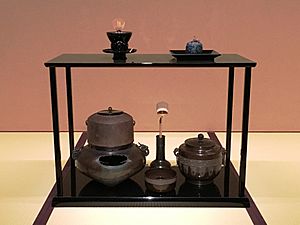Mushakōjisenke facts for kids
Mushakōjisenke (武者小路千家) (sometimes called Mushanokōjisenke) is one of the main schools for the Japanese tea ceremony. This school, along with Urasenke and Omotesenke, comes from the famous Sen family. These three schools are known as the "three Sen houses" (san-Senke). The leader of the Mushakōjisenke school is called the iemoto. This leader always has the special name Sōshu.
Contents
The Story of Mushakōjisenke
The Mushakōjisenke school started with Ichiō Sōshu (一翁宗守). He was the great-grandson of Sen no Rikyū, a very important person in the history of the tea ceremony. Ichiō Sōshu was the second oldest of Sen no Sōtan's four sons.
For a long time, Ichiō Sōshu lived away from his family. During this time, he became a skilled artist who worked with lacquer. Lacquer is a special type of varnish used to decorate objects.
Starting the Tea House
Later, his younger brothers asked him to start his own tea house. He agreed and opened a tea house called Kankyū-an. This tea house was on Mushakōji street. From then on, Ichiō Sōshu spent his life teaching and practicing the Way of Tea. The "Way of Tea" is another name for the Japanese tea ceremony.
Serving the Matsudaira Clan
Ichiō Sōshu was also chosen to be the tea teacher for the powerful Matsudaira family. This family lived in Takamatsu, in a place called Sanuki Province. For many generations, the leader of the Mushakōjisenke family served the Matsudaira family of Takamatsu. This continued until the Meiji Restoration, a big change in Japan's history.
Leaders Through the Years
The Mushakōjisenke school has had many leaders, called iemoto, over the years. Each leader carries on the traditions and teachings of the school. Here is a list of the leaders from the very first one:
| Generation | Personal name | Buddhist name | ||
|---|---|---|---|---|
| 1st | Rikyu Sōeki (1522–91) | 利休宗易 | Hōsensai | 抛筌斎 |
| 2nd | Shōan Sōjun (1546–1614) | 少庵宗淳 | ||
| 3rd | Genpaku Sōtan (1578–1658) | 元伯宗旦 | Totsutotsusai | 咄々斎 |
| 4th | Ichiō Sōshu (1605–1676) | 一翁宗守 | Jikyūsai | 似休斎 |
| 5th | Bunshuku Sōshu (1658–1708) | 文叔宗守 | Kyoyūsai | 許由斎 |
| 6th | Shinpaku Sōshu (1693–1745) | 真伯宗守 | Seiseisai | 静々斎 |
| 7th | Kensō Sōshu (1725–1782) | 堅叟宗守 | Jikisai | 直斎 |
| 8th | Kyūō Sōshu (1763–1838) | 休翁宗守 | Ittotsusai | 一啜斎 |
| 9th | Nin'ō Sōshu (1795–1835) | 仁翁宗守 | Kōkōsai | 好々斎 |
| 10th | Zendō Sōshu (1830–1891) | 全道宗守 | Ishinsai | 以心斎 |
| 11th | Issō Sōshu (1848–1898) | 一叟宗守 | Isshisai | 一指斎 |
| 12th | Chōshō Sōshu (1889–1953) | 聴松宗守 | Yūkōsai | 愈好斎 |
| 13th | Tokuō Sōshu (1913–1999) | 徳翁宗守 | Urinsai | 有隣斎 |
| 14th (current iemoto) | Sen Sōshu (born 1945) | 宗守 | Futessai | 不徹斎 |


